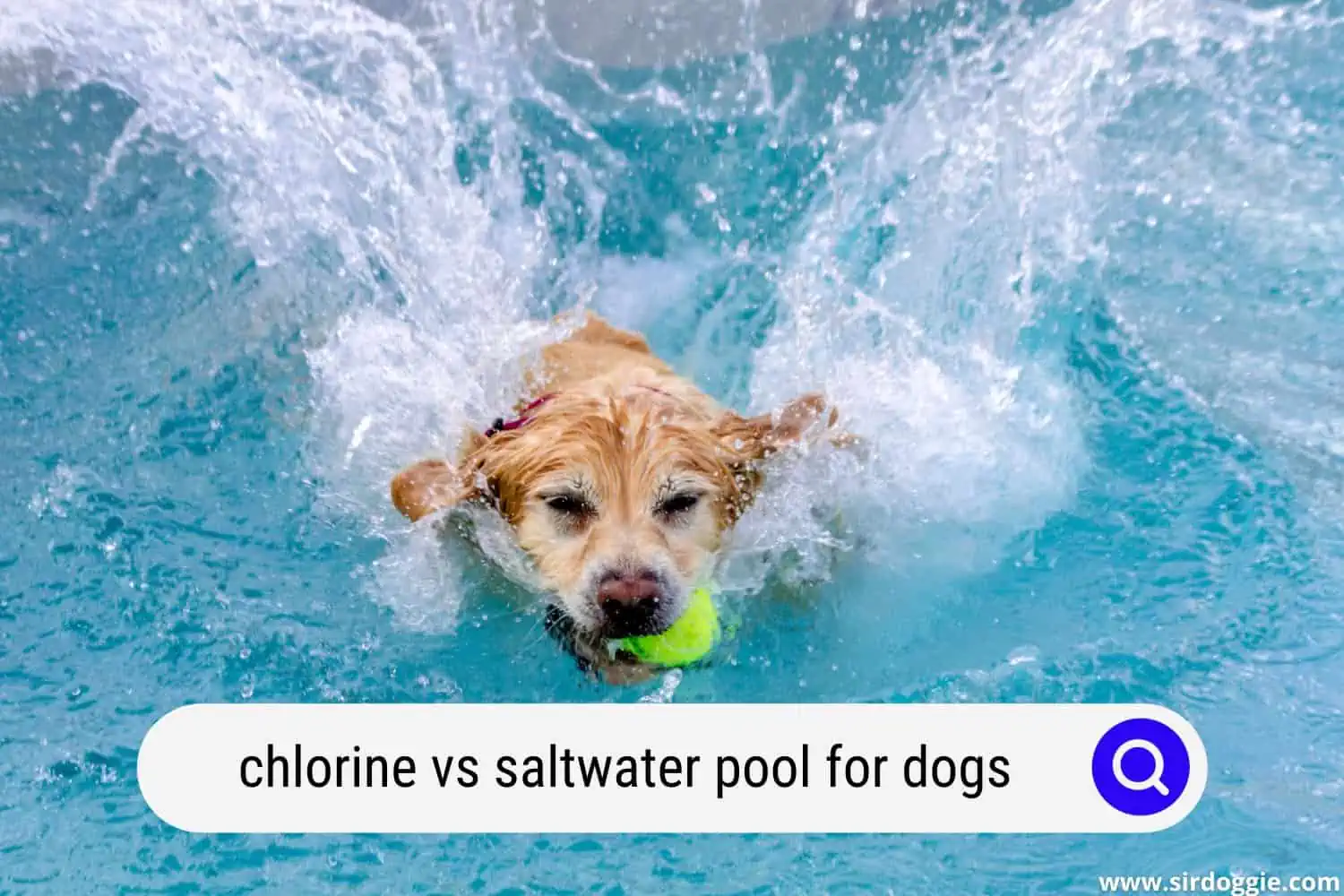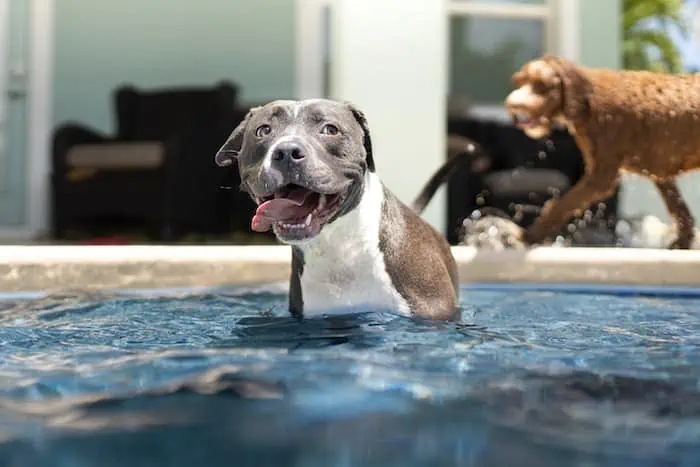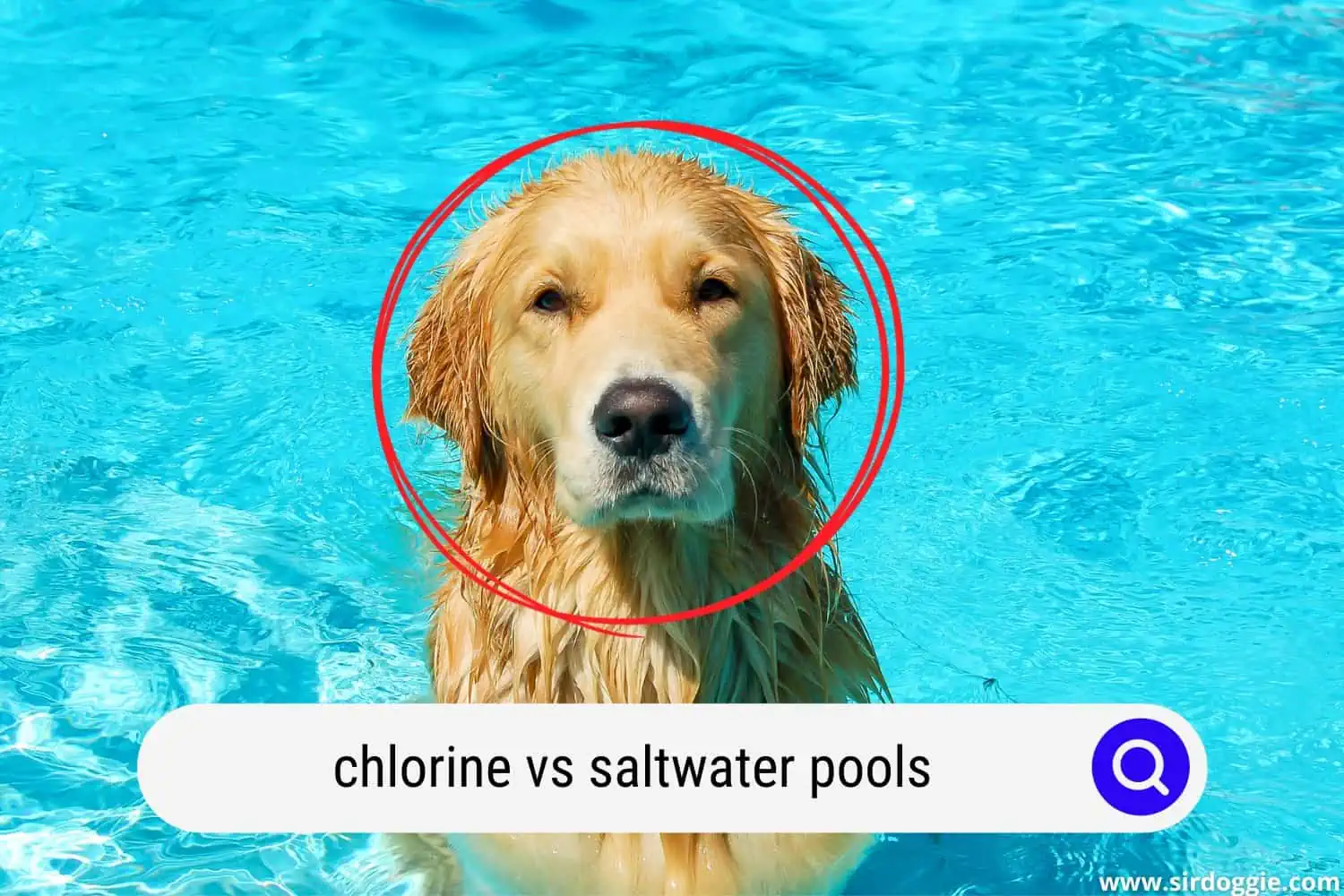Chlorine vs. Saltwater Pools: Which is Safest For Dogs?
If you are the proud owner of a man’s best friend, you can likely relate to the experience of witnessing your furry pet dive into a swimming pool to splash around on a hot day. Getting to watch or join in with your dog as they swim and play in the water can be entertaining to many people, but it raises the question of which type of pool is safest for dogs: chlorinated or saltwater?

The answer to this is a bit complicated, but both have pros and cons in different areas. Saltwater pools are generally safer for dogs when it comes to their skin and fur because chlorine is so irritating by comparison and can also burn their eyes. However, when it comes to ingesting the water itself, whether intentionally or on accident, both pools come with their risks.
Both of these pools have their pros and cons, so it’s a good idea to base your dog’s ability to play in one upon their health concerns, breed, size, and your ability to control what all chemicals or substances are present in the water in the pool of your choice.
Related Reading: 3 Best Above Ground Pool Dog Ramp [REVIEWED]
Chlorinated Pools or Saltwater Pools: A Detailed Comparison
If you’re one of the increasing numbers of people who have chosen a saltwater pool over a chlorinated pool, you may be wondering whether it provides a safer swimming environment for your dog. As the name implies, saltwater pools utilize salt to clean and sterilize the pool water rather than chlorine to accomplish the task.
Additionally, while the saltwater found in seas and the ocean can make your canine sick, the quantity of salt found in a pool sanitation system (about 10% of the level found in ocean water) is deemed acceptable for your dog to paddle around in for a short while. In most cases, it would seem that saltwater pools are primarily safer for dogs than chlorinated pools.
However, you’ll need to remember to strictly control the salt concentration in your pool water because any increase in your dog’s salt consumption may lead him to become more thirsty, causing him to drink more water. Certain dogs may also be at risk for a life-threatening condition called GDV (gastric dilatation volvulus) when consuming too much water too quickly when feeling dehydrated due to a higher sodium intake, so this is a concern to keep in mind when allowing your dog to play around in water he may potentially ingest.
Chlorinated pools are generally seen as less safe for pets because the concentrated form of chlorine that is used to disinfect the pool can be lethal to them if enough is ingested. However, if properly used, a pool’s chlorine level should not be much higher than that of most locations’ tap water levels.
Even without consuming any to harm their digestive tracts though, high levels of chlorine can irritate their skin, fur, eyes, and other sensitive areas simply from exposure.
Note: Concentrated chlorine tablets must be stored in their original container and in a location that is out of reach of curious dogs and children.
Let’s have a look at both these pools’ basics and their implications for canines.
Saltwater Pools
Just as the name suggests, saltwater pools employ salt to clean and disinfect the water in the pool.
Saltwater pools, which are far less harsh than pools containing large volumes of chlorine, are much less harmful to your dog than regular chlorine pools, provided that they are properly maintained. Don’t anticipate a saltwater pool to be just like the ocean, though—saltwater pools often have a salt concentration of around 3,300 ppm (parts per million), and ocean water has a salt content of nearly 36,000 ppm.
Although it is not completely necessary, it is still a good idea to give your dog a thorough freshwater washing or good rinse once he has finished swimming.
When present in significant amounts, salt can be very hazardous to your dog. Always make sure your buddy has enough fresh, safe-to-drink tap or filtered water available while he’s having a good time in the pool so he doesn’t get tempted to drink any of the salty water.
Keep a close eye out for indicators of salt sickness—initial symptoms such as weakness, lethargy, anorexia, vomiting, diarrhea, trembling, excessive thirst, frequent urination, tremors, stumbling, and seizures are all possible indicators. Seek emergency veterinarian care if your dog exhibits any indications of salt toxicity or dehydration.
Dogs that are on a low-sodium diet due to health problems such as heart disease or renal illness should not be permitted to drink from saltwater swimming pools whatsoever. Due to the significant risk, they should not even be permitted to swim in them.
Additionally, swimming can cause dogs to become rapidly fatigued. Never leave your dog unsupervised in any type of water, and always provide an easily accessible escape path out of the pool or water feature. If your dog becomes overtired while swimming, he will want your assistance to help get him out of the water.

Chlorinated Pools
When human beings swim in a pool, the majority of chlorine levels are considered acceptable, even if we accidentally consume some of the pool water. However, dogs have more sensitive eyes and ears compared to their owners, and this can make them more prone to chlorine poisoning. Typically, the only way they will come into contact with such high levels of chlorine would be through direct contact with the chlorine tablets themselves or an improperly managed chlorinated pool with excessive levels of the chemical present.
Unrelated to the chlorine itself, dogs with floppy ears are also more susceptible to ear infections as a result of the wetness from getting soaked or being submerged in a pool, so this is another concern to keep in mind.
Making Chlorine Safer for Dogs
AKC doctors say that chlorine is not something most dog owners should worry about because the amount in a pool is tiny. However, as noted above, the most dangerous concerns pertain to dogs getting into the chlorine tablets themselves; therefore, they must be stored in an area where a dog cannot easily get to eat them. Some canine owners choose to use non-chlorine-based chemicals in their pools, such as bromine since these are less harmful to their dogs.
If your pet does decide to jump in the pool, give him a brief wash or rinse when he comes out and is done to eliminate any excess chemicals lingering on him from the water. Keep in mind to also swab your dog’s ears with a cloth to avoid excess moisture and potential infection.

FAQs
Is pool water harmful to dogs?
If your pup consumes an excessive amount of chlorinated pool water, the water may irritate their gastrointestinal tract. This can result in vomiting, nausea, and erosion of the esophagus, and is why it is critical to keep your dog away from the pool when the chlorine levels are higher than normal. Your pool may require a chemical shock to restore equilibrium at times, and you should never allow your dog to swim in the pool while the chemical levels are elevated.
However, this does not imply that you should reduce the amount of chlorine in your pool. Without proper cleaning, pool water can contain germs, fungi, parasites, and algae—all of which can be harmful to swimmers. These can significantly impact both your dog and you if they are ingested, inhaled, or come into contact with your skin.
When you’re out in the yard, be sure that you don’t allow your dog to utilize the pool as its primary water supply. Make sure that you keep a fresh dish of clean water available for your canine companion at all times.
Does a dog cause damage to a pool?
Depending upon both the dog as well as the pool, it’s worth considering the possible impact that your dog may have on a pool. A dog’s claws can easily rip through plastic and vinyl liners along with leaving scuffs and scratches.
If you let your dog swim in your pool, you will also likely need to clean your filter even sooner since the dog’s hair, dander, and other debris will end up in the water.
It is also wise to test the pH of the water to ensure no other unexpected changes have occurred either. Also, it may be of assistance in mitigating these side effects if you hose your dog down before he enters the swimming pool, removing the most problematic concerns from the surface of your dog’s fur and skin before they have a chance to contaminate the pool water.
Related Reading: How Long Can A Dog Swim Before Drowning?

Family Dog Expert Author
Hi there! I’m Stuart, a devoted dog lover and family dog expert with over a decade of experience working with our furry companions. My passion for dogs drives me to share my knowledge and expertise, helping families build strong, loving bonds with their four-legged friends. When I’m not writing for SirDoggie, you’ll find me hiking, playing with my beautiful dog, or studying music.